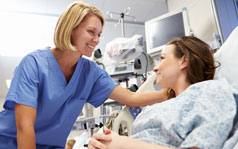Hip Arthroscopy
Contact Us
Please note that a referral letter is required before an appointment can be confirmed.
Please note that a referral letter is required before an appointment can be confirmed.
Useful Information
About this service
Arthroscopy is a surgical procedure that gives doctors a clear view of the inside of a joint. This helps them diagnose and treat joint problems.
Doctors may recommend hip arthroscopy when a patient is experiencing pain in the hip joint that does not respond to non-surgical treatment including rest, physical therapy, medication and injections that reduce inflammation. Inflammation is one of the body’s normal reactions to injury or disease; in an injured or diseased hip joint inflammation causes swelling, pain and stiffness.
The surgeon will examine the inside of the hip joint using a small telescope or arthroscope. For the procedure, several small incisions are made into the joint. The arthroscope is inserted and this allows the surgeon to have a look at your joint which they will then view on a TV monitor. When a problem is identified the surgeon can perform a range of procedures using small instruments inserted through a separate incision.
Patients undergoing hip arthroscopy will require a physical examination by their surgeon to assess their overall health. This is carried out in order to identify any problems that might interfere with or prevent the procedure from going ahead.
Patients with certain health risks may require a more extensive assessment prior to the procedure.
Patients should inform their surgeon of any medication that they are taking so that they can be advised if they should continue or stop taking it prior to the procedure.
A member of the team will contact each patient ahead of time to provide specific details of the procedure. This will include details of when to arrive and any fasting instructions.
Hip arthroscopy is most commonly performed under general anesthesia, whereby patients will be asleep for the duration of the procedure.
At the start of the procedure, the leg will be put in traction. This means that the hip will be pulled away from the socket just enough for the surgeon to insert instruments, see the entire joint, and perform the treatment required.
After traction is applied, the surgeon will make a small incision in the hip (about the size of a buttonhole) for the arthroscope. Through the arthroscope, they can view the inside of the hip and identify any damage.
The surgeon will insert other instruments through separate incisions to treat the problem. A range of procedures can be carried out, depending on the patient's needs. The length of the procedure will depend on what the surgeon finds and the amount of work to be carried out.
After surgery, patients will stay in the recovery room for one to two hours before being discharged home.
Patients will need someone to drive them home and stay with them for at least the first night.
In some cases, crutches are necessary, but only until any limping has stopped. However, if a patient requires a more extensive procedure, crutches may be required for one to two months.
Patients will be given specific physiotherapy exercises to restore strength and mobility. The physiotherapist will guide patients as to the dos and don’ts when at home.
For some people, lifestyle changes are necessary in order to protect the joint. An example might be changing from high impact exercise (such as running) to lower impact activities (such as swimming or cycling). These are decisions patients will make with the guidance of the surgeon.
As surgery goes, arthroscopy is very safe. However, as with any surgery, some patients develop unexpected complications.
Any surgery in the hip joint carries a small risk of injury to the surrounding nerves or vessels, or the joint itself. The traction needed for the procedure can stretch nerves and cause numbness, but this is usually temporary.
There are also small risks of infection, as well as blood clots forming in the legs (deep vein thrombosis).







.jpg?sfvrsn=4ae04bd7_1)


